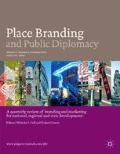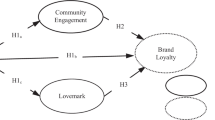Abstract
The aim of this paper is to examine to what extent nation branding can be applied to the European Union (EU) concerning EU efforts to enhance its image and reputation, particularly after the arrival of several crises such as the economic and migration crisis, Brexit, etc. Exploring previous but also current attempts of the EU to better communicate itself, the paper shows how EU communication shifted from communication campaigns focused on politicized issues such as EU citizenship, “EU public sphere” and a “common sense of belonging” to a more pragmatic “branding” strategy. The sui generis nature of the EU is also taken into consideration in a comparative analysis between nation and EU branding displaying similarities, particularities or constraints the EU presents regarding branding issues. Emphasis is also put on the May 2019 European Parliament election campaign where the new EU branding strategy was applied more systematically.
Similar content being viewed by others
Notes
Anholt (2008).
Anholt (2007b).
Commission of the European Communities (2005b, 13 October 2005).
Commission of the European Communities (2005a, 20 July 2005).
Ibid., p. 3.
Commission of the European Communities 2006.
Valentini and Nesti (2010, p. 8).
Habermas (1989).
Valentini and Nesti (2010). “In their recent analysis of the question of the democratic deficit in the EU, Follesdal and Hix (2006) mention, as causes of its weak popular legitimacy, the excessive power hold by national executives within the Council against the legislative, the limited competencies conferred to the European Parliament and the presence of weak electoral mechanisms.” It should though be mentioned that the role of the European Parliament has since then been reinforced in the domain of the EU budget and legislation as well as in the election of the European Commission President.
Tsoukalis et al. (2009, p. 18).
European Commission (2009).
European Parliament Research Service (2016).
Connor (2018, 19 September 2018).
For the approach of input legitimacy that is based on a shared European identity and procedures vs the output legitimacy that is based on the ability of the EU to deliver results for European citizens, see Tsoukalis et al. (2009, pp. 21–22).
Surowiec (2017).
For a thorough analysis concerning the technical-economical, political and cultural approach on nation branding see Kaneva (2011), https://ijoc.org/index.php/ijoc/article/view/704.
The Europe-wide student competition to design a new logo and slogan for Europe in celebration of the 50th anniversary of the Treaty of Rome in 2007 was a first but inconsistent attempt to create a “brand identity” without taking into account that the EU brand itself was vague and unclear. A thorough analysis about the EU Birthday Logo Competition can be found in: Aiello (Aiello 2012) and in Anholt (2007b, p. 118).
Tschauko (2017).
Sebe and Gigi (2011).
Russack (2019).
Gudjonsson (2005)
Anholt, “Brand Europe,” 115–119.
Ibid.
European Commission (2018a).
Ibid., p. 3.
Ibid., p. 6.
Van den Brande (2017).
Munin (2019, p. 52).
Commission of the European Communities Commission of the European Communities (2019).
Landabaso (2017).
Van Ham (2001).
Anholt (2007a).
Fan (2006, pp. 1, 10).
Cunningham et al. (2019, p. 2).
Youngs, 10 June (2019).
Commission of the European Communities (2019).
The term “populist” is used in the European Commission’s text with no further analysis or definition. It should be noted that the term “populism” is a contested concept used to denote very diverse political and socioeconomic phenomena from the ultimate expression of the general will (Volonté Générale) of the people, to the antagonism of the “pure people” versus the “corrupt elite” or an “anti-immigration” and “xenophobic” rhetoric. When it comes to the EU, the word “populism” is very often used to describe an array of opinion and attitudes from those who oppose to the European integration project preferring a more intergovernmental EU or those who ask for a more participatory and democratic process in the EU decision-making, to those who are clearly anti-EU or contest political liberalism values. It should be noted though that such an analysis is beyond the scope of this paper. For a thorough analysis about “populism” see Mudde (2004). For an analysis about “populism” in Europe see Jones (2019).
Although the election campaign was mainly conducted by the European Parliament and the European Commission, it is considered an EU campaign since the campaign was in line with the new EU branding communication approach.
European Parliament (2019b, 16 April 2019).
European Commission (2018b, 19 December 2018).
European Parliament (2019a, 7 May 2019).
European Parliament (2019c, 23 October 2019).
Bolin et al. (2019).
Anholt (2010).
References
Aiello, Giorgia. 2012. All Tögethé® now: The recontextualization of branding and the stylization of diversity in EU public communication. Social Semiotics 22 (4): 459–486.
Anholt, Simon. 2007a. Competitive identity: A new model for the brand management of nations, cities and regions. Policy & Practice: A Development Education Review 4: 3–13.
Anholt, Simon. 2007b. Editorial ‘Brand Europe’—Where next? Place Branding and Public Diplomacy 3: 115–119. https://doi.org/10.1057/palgrave.pb.6000061.
Anholt, Simon. 2008. From nation branding to competitive identity—The role of brand management as a component of national policy. In Nation branding—Concepts, issues, practice, ed. Dinnie Keith, 22–23. Oxford: Elsevier Butterworth-Heinemann.
Anholt, Simon. 2010. Why ‘Nation Branding’ doesn’t exist. Economic Times. https://economictimes.indiatimes.com/why-nation-branding-doesntexist/articleshow/5799304.cms. Accessed 20 Feb 2020.
Bolin, Niklas, Kajsa Falasca, Marie Grusell, and Lars Nord. 2019. Euroflections—Leading academics on the European elections 2019 (Mittuniversitetet, Demicom, Sundsvall, Sverige). https://euroflections.se/globalassets/ovrigt/euroflections/euroflections_v3.pdf Accessed 24 July 2020.
Chopin, Thierry. 2018. Europe and the identity challenge: Who are “we”? Policy Paper European Issues No 466. Fondation Robert Schuman.
Commission of the European Communities. 2005a. Action Plan to improve communicating Europe by the Commission. https://ec.europa.eu/transparency/regdoc/rep/2/2005/EN/2-2005-985-EN-F-0.Pdf. Accessed 21 Feb 2020.
Commission of the European Communities. 2005b. The Commission’s contribution to the period of reflection and beyond: Plan-D for democracy, dialogue and debate. https://eur-lex.europa.eu/LexUriServ/LexUriServ.do?uri=COM:2005:0494:FIN:EN:PDF. Accessed 21 Feb 2020.
Commission of the European Communities. 2006. White Paper on a European communication policy. http://europa.eu/documents/comm/white_papers/pdf/com2006_35_en.pdf. Accessed 21 Feb 2020.
Commission of the European Communities. 2019. Preparing for a more united, stronger and more democratic Union in an increasingly uncertain world. https://ec.europa.eu/commission/sites/beta-political/files/euco_sibiu_communication_en.pdf. Accessed 21 Feb 2020.
Connor, Phillip. 2018. A majority of Europeans favor taking in refugees, but most disapprove of EU’s handling of the issue. Pew Research Center. https://www.pewresearch.org/fact-tank/2018/09/19/a-majority-of-europeans-favor-taking-in-refugees-but-most-disapprove-of-eus-handling-of-the-issue/. Accessed 24 Feb 2020.
Cunningham, Kevin, Simon Hix, and Michael Marsh, Susi Dennison. 2019. Kingmakers of the mainstream: Predictions for the European Parliament Election. European Council on Foreign Relations Report. https://www.ecfr.eu/publications/summary/kingmakers_of_mainstream_predictions_for_european_parliament_election. Accessed 22 July 2020.
European Commission. 2009. Public opinion in the European Union Standard Eurobarometer 71. http://ec.europa.eu/commfrontoffice/publicopinion/archives/eb/eb71/eb71_std_part1.pdf. Accessed 24 Feb 2020.
European Commission. 2018a. Communication to the Commission from President Juncker and Commissioner Oetinger. Corporate communication activities action in 2019-2020 under the Multiannual Financial Framework 2014-2020. https://ec.europa.eu/transparency/regdoc/rep/3/2018/EN/C-2018-4063-F1-EN-MAIN-PART-1.PDF. Accessed 21 Feb 2020.
European Commission. 2018b. Management Plan 2019 DG Communication. https://ec.europa.eu/info/sites/info/files/management-plan-comm-2019_en_0.pdf. Accessed 18 Feb 2020.
European Commission. 2019. Public opinion in the European Union Standard Eurobarometer 91.https://ec.europa.eu/commfrontoffice/publicopinion/index.cfm/survey/getsurveydetail/instruments/standard/surveyky/2253. Accessed 28 Feb 2020.
European Parliament. 2019a. European Elections 2019—Official clip “Choose your Future”. https://multimedia.europarl.europa.eu/en/european-elections-2019-official-clip-choose-your-future-hero_I171941-V_v. Accessed 27 Feb 2020.
European Parliament. 2019b. European elections 2019, Press Service. https://www.europarl.europa.eu/pdfs/news/expert/2019/2/service/20180820SRV10205/elections-press-kit-en.pdf. Accessed 25 Feb 2020.
European Parliament. 2019c. European election results. https://www.europarl.europa.eu/election-results-2019/en. Accessed 24 Feb 2020.
European Parliament Research Service. 2016. Major changes in European public opinion regarding the European Union. https://www.europarl.europa.eu/at-your-service/files/be-heard/eurobarometer/2016/major-changes-in-european-public-opinion-2016/report/en-report-exploratory-study-201611.pdf. Accessed 24 Feb 2020.
Fan, Ying. 2006. Branding the nation: What is being branded? Journal of Vacation Marketing 12 (1): 5–14. https://doi.org/10.1177/1356766706056633.
Follesdal, Andreas, and Simon Hix. 2006. Why there is a democratic deficit in the EU: A response to Majone and Moravcsik. Journal of Common Market Studies 39 (3): 443–462.
Gudjonsson, Hlynur. 2005. Nation branding. Place Brand and Public Diplomacy 1: 283–298. https://doi.org/10.1057/palgrave.pb.5990029.
Habermas, Jürgen. 1989. The stuctural transformation of the public sphere: An inquiry into a category of bourgeois society. Cambridge: Polity Press.
Jones, Erik. 2019. Populism in Europe: What scholarship tells us. Survival 61 (4): 7–30.
Kaneva, Nadia. 2011. Nation branding: Toward an agenda for critical research. International Journal of Communication 5: 117–141.
Landabaso, Mikel. 2017. Communicating Europe. The new approach of the European Commission. Presentation of the Director of Strategy and Corporate Communication of the European Commission in the European Committee of the Regions. https://cor.europa.eu/Documents/Migrated/events/presentation-CoR-Final-28.3.pdf. Accessed 24 Feb 2020.
Malherbe, Michael. “Le ‘branding’ de l’Europe, une fausse bonne idée?”. Décrypter la communication européenne. March 2018. https://www.lacomeuropeenne.fr/2018/03/05/le-branding-de-l-europe-une-fausse-bonne-idee/. Accessed 24 Feb 2020.
Mudde, Cas. 2004. The populist zeitgeist. Government & Opposition. 39 (4): 543–544.
Munin, Nellie. 2019. Debating over European Union’s future: Re-politicisation and back to direct democracy? Humanities and Social Sciences: Latvia 27 (1): 47–72. https://doi.org/10.22364/hssl.27.1.03.
Rasmussen, Steffen Bay. 2009. Discussion Papers in Diplomacy. Discourse Analysis of EU Public Diplomacy, Messages and Practices. Netherlands Institute of International Relations ‘Clingendael’.https://www.clingendael.org/sites/default/files/pdfs/20090700_cdsp_discussion_paper_115_Rasmussen.pdf. Accessed 24 Feb 2020.
Rohac, Dalibor. 2019. 5 lessons from the European election. Politico, May 27. https://www.politico.eu/article/5-lessons-from-the-european-parliament-election-2019/. Accessed 24 Feb 2020.
Russack, Sophia. 2019. EU Parliamentary democracy: How representative? CEPS, policy insights https://www.ceps.eu/wp-content/uploads/2019/05/PI2019_07_SR_EU-parliamentary-democracy-1. Accessed 20 Jul 2020.
Sebe, Mihai, and Mihaita Gigi. 2011. How to Brand an International Organization: NATO Case Study. EIRP Proceedings 6: 563–567.
Surowiec, Pawel. 2017. Is corporatisation of soft power failing strategic communicators? Convergences—Public Communication in Europe. 10: 37–38.
Szondi, György. 2008. Public diplomacy and nation branding: Conceptual similarities and differences. In Discussion papers in diplomacy, ed. Virginie Duthoit and Ellen Huijgh, 1–42. Netherlands Institute of International Relations ‘Clingendael’.
Tschauko, Stefan. 2017. Strategic communication and branding in International Organizations: The case of the United Nations—UN-internal perspective on branding at the UN-Secretariat and the UN-system-wide level. Report of the Master’s Thesis research. The Fletcher School. http://sites.tufts.edu/stefantschauko/. Accessed 20 July 2020.
Tsoukalis, Loukas, Olaf Cramme and Roger Liddle. 2009. An EU ‘fit for purpose’ in the global age. Can we rise to the challenge? Policy Network Archive. https://www.eliamep.gr/wp-content/uploads/2009/11/euffp-can-we-rise-to-the-challenge-1.pdf. Accessed 20 Feb 2020.
Valentini, Chiara, and Giorgia Nesti. 2010. Public communication in the European Union: History, perspectives and challenges. Cambridge: Cambridge Scholars Publishing.
Van den Brande, Luc. 2017. Reaching out to EU citizens: A new opportunity ‘About us, with us, for us’. Luxembourg: Publications Office of the European Union. https://ec.europa.eu/commission/sites/beta-political/files/reaching-out-to-citizens-report_en.pdf. Accessed 24 Feb 2020.
Van Ham, Peter. 2001. The rise of the brand state: The postmodern politics of image and reputation. Foreign Affairs 8 (5): 2–6.
Youngs, Richard 2019. Democracy after the European Parliament elections. CEPS policy insights. https://www.ceps.eu/ceps-publications/democracy-after-the-european-parliament-elections/ Accessed 23 July 2020.
Author information
Authors and Affiliations
Corresponding author
Ethics declarations
Conflict of interest
The author states that there is no conflict of interest.
Additional information
Publisher's Note
Springer Nature remains neutral with regard to jurisdictional claims in published maps and institutional affiliations.
The article is based on a presentation of the author during the 4th Annual Conference of IPBA (2019) and does not reflect the official policy or position of the Greek Ministry of Foreign Affairs. This article won the Palgrave best conference paper award at the Fourth Annual Conference of the International Place Branding Association in Volos, Greece, November 27–29 2019.
Rights and permissions
About this article
Cite this article
Elmatzoglou, I. EU branding. Efforts to improve the EU image. Place Brand Public Dipl 16, 326–335 (2020). https://doi.org/10.1057/s41254-020-00180-5
Revised:
Published:
Issue Date:
DOI: https://doi.org/10.1057/s41254-020-00180-5




